A new study has found an unexpected link between languages — all over the world, the sounds we use to form words for common objects and ideas are surprisingly similar. Could we all, in fact, be talking the same language?

One of the core principles of linguistics is that languages appeared and evolved independently of each other. Language, in other words, is a creation of the people speaking it. This would mean that the sounds that we use to create words have no sense in themselves, but serve to create something with meaning — just like a bunch of shapeless rocks have no purpose until you mortar them together to make a wall.
But what if those rocks weren’t so shapeless after all? A new study performed by a team including physicists, linguists, and computer scientists from the US, Argentina, Germany, the Netherlands and Switzerland analyzed 40-100 basic vocabulary words in around 3,700 languages – approximately 62 per cent of the world’s current languages. They found that humans use surprisingly similar sounds to form the words for basic concepts such as body parts, family relationships or parts of the natural world. This would suggest that concepts fundamental to human life instinctively evoke the same verbalizations from all of us.
“These sound symbolic patterns show up again and again across the world, independent of the geographical dispersal of humans and independent of language lineage,” said Dr Morten Christiansen, professor of psychology and director of Cornell’s Cognitive Neuroscience Lab in the US where the study was carried out.
“There does seem to be something about the human condition that leads to these patterns. We don’t know what it is, but we know it’s there.”
The team found that in most languages, the word for nose was likely to include the group “neh” of the “oo” sound (as in coop.) The word for sand was likely to include the sound “s” and “leaf” the “l,” “p” or “b” sounds. The words for ‘red’ and ‘round’ were likely to include the ‘r’ sound, they found.
Other words were likely to share sound groups across languages, including bite, dog, fish, skin, water, and star. For words describing parts of the body, such as knee or breast, these associations were even stronger.
“It doesn’t mean all words have these sounds, but the relationship is much stronger than we’d expect by chance,” added Dr Christiansen.
There are also negative associations — meaning that there are sounds or groups of sounds that words for the same objects or concepts avoid across languages. This was most evident with pronouns, with the words for first person singular, I, unlikely to include the sounds u, p, b, t, s, r and L. ‘You’ is unlikely to include sounds involving u, o, p, t, d, q, s, r and L.
The study, however, doesn’t address the question of why this happens. So we have no explanation why humans seem compelled to use the same sounds for basic objects or ideas, but of course, the scientists have a few theories. Dr Christian believes that because these concepts are important in all languages, so children are likely to learn these words early in life.
“Perhaps these signals help nudge kids into acquiring language,” he added: “Maybe it has something to do with the human mind or brain, our ways of interacting, or signals we use when we learn or process language. That’s a key question for future research.”
And other studies seem to back the idea of sound-object associations underlying language. They found, for example, that regardless the language, words for small spiky objects are likely to contain high-pitched sounds, while rounder shapes contain ‘ooo’ sounds, now known as the ‘bouba/kiki’ effect.
There’s also the possibility that some words share sounds across languages because they’re the first tentative vocalizations babies make — so ma, ma, and da, da, become mama and daddy.
“You could argue that the words chosen here are very old and therefore most likely to have a common ancestor language in the past, from which they all derived,” said Dr Lynne Cahill, a lecturer in English Language and Linguistics at the University of Sussex
“I think this is an interesting study which has looked at so many languages but I don’t think it quite justifies their claim that it debunks the idea that language is arbitrary and I think they looked at too few words to make any firm conclusions.”
The full paper “Sound–meaning association biases evidenced across thousands of languages” has been published in the journal Proceedings of the National Academy of Sciences.






